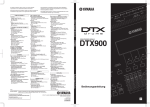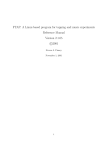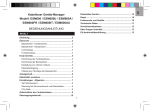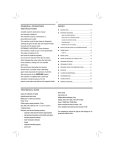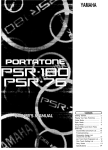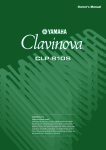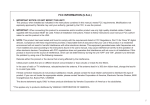Download Yamaha PortaSound PSS-7 Instruction Manual
Transcript
1/3 Owner’s Manual A Der STAND BY—ON-Schalter A The STAND BY — ON switch. To parents Please read the instructions in this manual to your children. Not suitable for children under 3 years due to small size of some components. Wenn der STAND BY—ON-Schalter auf “ON” geschoben wird, erklingt eine Fanfare, und man kann auf dem PSS-7 spielen. Zum Ausschalten wird der Schalter wieder auf “STAND BY” geschoben. Slide the STAND BY–ON switch to the “ON” position and you will be greeted with a fanfare and can play PSS-7. Slide the switch to the “STAND BY” position to turn the PSS-7 off. • If you leave the switch “ON”... If the switch is left “ON”, the PSS-7 will sound an alert. Make sure you slide the switch to the “STAND BY” so that you don’t waste battery power. If the switch is still left “ON”, and the keyboard is not touched for a period of 10 minutes, a confirmation alert will sound. If the keyboard is still not touched, the alert will sound every 10 minutes. , VOLUME buttons volume button, the “PON” sound you hear Press the will be a little louder. Press the volume button, the “PON” sound you hear will be a little softer. E ● Selecting normal instruments. There are100 types of instrument sounds in the PSS-7. Let’s try to play some of the 25 normal instrument sounds (shown on the panel). Press the yellow button once and the instrument that sounds will be the first instrument in the INSTRUMENTS list (Keyboard/Strings). Press the yellow button once and the instrument that sounds will be the first instrument in the INSTRUMENTS list (Wind & Mallet/Sound effect). The next time you press either of the buttons, the next instrument in the list will be selected. F ● Selecting variation instruments. All of the instruments listed on the panel have three variations (25 x 3 = 75 types). Look at the instrument list and try to select and play some of the different types of instruments (Effect/Phrase/Funny). To select a variation instrument, press the orange button. Every time you press button, the Normal m Effect m Phrase m Funny m Normal m ... variations will be selected in that order. For example, when the piano (normal) is selected, and the button is pressed, m Sustain Piano m Ragtime Piano m Game Over m Piano (Effect) (Phrase) (Funny) (Normal) will be selected in that order. Try this one for fun! Have fun playing percussion. Press the yellow button so that “PERCUSSION” is selected, play on the keyboard and you will hear many different percussion instruments. Press the green button, and play the “Safari” or “Carnival” . OK, are you feeling like a drummer? Let’s play along with the band performance. Click Bass Drum Snare Rim Shot When you press the green button, the first song in the list, “Music Box” will start. The next time you press, the second song “Gymnopedies”, starts, and so on. After the tenth song in the list, “Waltz”, the next song to be selected will be the first song in the list “Music Box”. • The band performance will continue to play button is pressed. until the red • To start the band performance from the beginning of the selected performance, press button to stop playback, then the red button to start playback press the of the performance from the beginning. • When you select a band performance, the tempo that matches that performance will be automatically selected. D • When you press the button, the selected instrument will sound and then you can play the instrument. Agogo High C Wood Wood Block Block High Low Closed Hi-hat Open Hi-hat M.D.G., EMI Division © 1997 Yamaha Corporation VZ02090 1/3 ???POCP??.?-03C0 Printed in Malaysia • Wenn das “PONG” beim Drücken der Taste [+] oder [–] nicht zu hören ist, war die größte oder kleinste Lautstärke bereits eingestellt. • Wenn man die Tasten [+] und [–] gleichzeitig drückt, wird auf Höchstlautstärke geschaltet. • Wenn der STAND BY — ON-Schalter auf “ON” gestellt wird, ist anfänglich die Höchstlautstärke eingestellt. When you press the button for the first time, the first instrument in the list will be selected. After that, every time you press the button, the next instrument in the list will be selected. You can select from five instruments (COMBO) in the button list. The COMBO is a preset band composed of standard instruments. After you select PERCUSSION, the next instrument selected will be PIANO. • If you press the yellow , or, button, the selected instrument will sound and then you can play that instrument on the keyboard. If you press the green third song, “Für Elise”, in the Spielen wir in einer Band! 1 Start “Für Elise”. Press the red ing. button three times, the list will start playing. 2 C Wenn Du die grüne -Taste dreimal drückst, wird , “Für Elise”, gestartet. der dritte Song von BANDS -Taste drückst, hört die Band Mit der Band spielen (Klavier, E-Gitarre usw.). Try pressing the yellow button. What kind of instrument do you hear? Every time you press the button, a different instrument plays. Use your ear to find the piano sound, which is the first instrument in the yellow list (COMBO). Are you feeling like a pianist? See if you can play along with the melody. Drücke nun einmal die gelbe -Taste. Welches Instrument hörst Du jetzt? Jedesmal, wenn Du die -Taste drückst, ist ein anderes Instrument zu hören. Versuche einmal, mit dem Ohr das Klavier (PIANO) zu finden. Dies ist das erste Instrument in der -Liste (COMBO). Jetzt bist Du der Klavierspieler der Band! Versuche einmal, ob Du zu der Melodie dazuspielen kannst. Press the yellow button and the sound you just played on the keyboard (PIANO) will change to E GUITAR, the second instrument in the yellow list. Are you feeling like a guitarist? See if you can play along. Wenn Du die -Taste noch einmal drückst, ist die E-Gitarre, das zweite Instrument in der gelben -Liste, zu hören. Jetzt bist Du der Gitarrist! Versuche, mit der Band zu spielen. Press the button again and try playing the SAXOPHONE, E BASS, or PERCUSSION parts in the group. Drücke danach wieder die -Taste, um Saxophon, E-Baß oder Schlagzeug zu spielen. “One, two, three!” Start the band! button to stop the band. 3 “Eins, zwei, drei!” Die Band im eigenen Tempo starten. Drücke die rote • Tap the button 4 times if the band performance is 4/4 time. • If you tap the button while the band performance is playing, the performance tempo will adjust to the same speed that you tapped. button too slowly, the tap • If you tap the function will not operate. If you tap the button too fast, the tempo will be set to 240 beats per minute. Im PSS-7 gibt es auch 30 Stücke mit einer kompletten Band (Begleitung). BANDS bietet einige großartige Rhythmen zum Dazuspielen, bei BANDS kann man einige nette klassische Stücke mit Melodien wählen, und die Stücke von BANDS sorgen für Extra-Spaß. Hören wir uns zunächst einmal “Für Elise” an, den dritten Song von BANDS . Versuche auch, als Bandmitglied eines der fünf COMBO-Instrumente zu spielen. “Für Elise” starten. Wenn Du die rote auf zu spielen. button, and the band stops play- Become a band member (piano/electric guitar, etc.) Press the red Nicht geeignet für Kinder unter 3 Jahre, da das Instrument kleine Bauteile aufweist. und Beim Drücken der -Taste wird das “PONG” ein wenig lauter. Beim Drücken der -Taste wird das “PONG” ein wenig leiser. Inside the PSS-7 there are 30 different kinds of band (accompaniment) performances. In the Bands list you’ll find some great rhythms to play along with, has some nice classic pieces with melodies, and has some fun pieces to play along with. First, let’s listen to “Für Elise”, which is the third song in the BANDS list. Just as if you are a member of a five-piece band (COMBO), play along with the band. Press the green button/ button, and in the same manner, the first song in the list/ list will start. Also, every time you press the button/ button, the next song in the list will start. The first song will be selected after the tenth song in the list. See the “Instrument List” on the reverse side. Agogo Low Try playing in the band. Lesen Sie Ihrem Kind bitte die Anweisungen vor, und erklären Sie ihm bitte auch die zusätzlichen Erläuterungen. B Die VOLUME-Tasten • If you press the [+] or [–] button and you don’t hear “PON”, the sound level is at its highest or lowest setting and cannot be adjusted further. • Simultaneously press the [+] and [–] buttons to set the volume level to its maximum setting. • The volume is set to its maximum setting when the STAND BY – ON switch is set to “ON”. ●First of all, let’s listen to the preset songs. Refer to “Let’s listen and play!” on the reverse side. Bedienungsanleitung • Wenn der Schalter auf “ON” gestellt bleibt, erklingt nach einer Weile ein Warnton. Wenn nicht mehr mit dem PSS-7 gespielt wird, sollte man nicht vergessen, den Schalter auf “STAND BY” zu schieben, damit kein Batteriestrom verschwendet wird. Wenn der Schalter auf “ON” steht und 10 Minuten lang nicht auf der Tastatur gespielt wird, gibt das Instrument einen Warnton von sich. Sollte auch danach nicht auf der Tastatur gespielt werden, ist der Warnton alle 10 Minuten zu hören. B The Congratulations on your purchase of the Yamaha PortaSound. You now own a portable keyboard that packs advanced functions and great sound in a highly compact size. Read this Owner’s Manual carefully while playing your new PortaSound in order to take full advantage of its various features. Liebe Eltern, Tap the button three times like this. “One, two, three”. Did the band start playing at the speed you tapped? One, two, three. You can change the band’s tempo, just like you did for the song, by using the tempo buttons. Wenn man die grüne -Taste drückt, startet der erste Song in der -Liste, “Music Box”. Beim nächsten Druck auf die Taste spielt der zweite Song, “Gymnopedies”, und so fort. Wenn auf diese Weise bis zum zehnten Song, “Waltz”, weitergeschaltet wurde, spielt beim nächsten Tastendruck wieder “Music Box”. Dasselbe gibt für die grüne -Taste/ Taste. Wenn man die Taste drückt, startet der erste Song in der / -Liste. Beim nächsten Druck auf die Taste spielt dann der nächste Song. Nach dem zehnten Song hört man dann wieder den ersten Song. • Die Band spielt so lange wiederholt weiter, -Taste drückt. bis man die rote • Wenn die Band noch einmal von Anfang an spielen soll, drückt man zum Stoppen die rote -Taste und dann wieder die BANDS, oder ). Taste ( • Beim Auswählen einer Band wird automatisch ein Tempo eingestellt, das zu dem Song paßt. -Taste, wie Eins, zwei, drei! Du kannst das Tempo der Band wie bei den Songs auch mit den TEMPO-Tasten und schneller oder langsamer machen. ●Hören wir uns zunächst einmal die vorprogrammierten Songs an. Siehe “Hören und spielen wir!” auf der Rückseite. E● Auswählen normaler Instrumente Das PSS-7 hat 100 verschiedene Instrumentklänge. Hören wir uns zunächst einmal die normalen Instrumente an (die Instrumente an der Frontplatte). Wenn man die gelbe -Taste einmal drückt, ist das erste Instrument von INSTRUMENTS (Tasten- und Saiteninstrumente) zu hören. Wenn man die gelbe -Taste einmal drückt, ist das erste Instrument von INSTRUMENTS (Blas- und Schlaginstrumente, Effekte) zu hören. Beim nächsten Drücken der Taste hört man dann das zweite Instrument in der Liste. F ● Auswählen der Variationsinstrumente Siehe “Instrumentenverzeichnis” auf der Rückseite. Für alle der Instrumente an der Frontplatte gibt es drei Variationen (25 x 3 = 75 Typen). Versuchen wir nun einmal, die Variationen (EFFECT/PHRASE/FUNNY) eines Instruments zu spielen. Zum Auswählen eines Variationsinstruments drückt man die orangefarbene -Taste. Bei jedem Drücken der Taste wird folgendermaßen umgeschaltet: NORMAL m EFFECT m PHRASE m FUNNY m NORMAL ... Wenn beispielsweise PIANO (normales Klavier) gewählt ist, kann man mit der -Taste folgende Variationen wählen: m Sustain Piano m Ragtime Piano m Game Over m Piano (EFFECT) (PHRASE) (FUNNY) (NORMAL) D Wenn man die -Taste das erste Mal drückt, wird das erste Instrument in der COMBO-Liste gewählt. Bei jedem weiteren Drücken der Taste wird dann das jeweils nächste Instrument gewählt. Es gibt fünf Instrumente in der COMBO-Liste, die alle mit der -Taste gewählt werden. Eine COMBO ist eine Band mit fünf Musikern. Nach PERCUSSION wird als nächstes Instrument wieder PIANO gewählt. • Beim Drücken der Taste , oder hört man den Klang des gewählten Instruments. -Taste, um die Band zu stoppen. Drücke nun dreimal so schnell auf die die Band spielen soll: “Eins, zwei, drei!”. Spielt die Band nun in diesem Tempo? Herzlichen Glückwunsch zum Yamaha PortaSound. Dieses tragbare Keyboard kombiniert fortschrittliche Funktionen und guten Klang in einem äußerst kompakten Instrument. Diese Anleitung ist als Leitfaden für die ersten Spielschritte gedacht und soll helfen, den Umgang mit den verschiedenen Funktionen zu erlernen. • Bei Stücken in 4/4-Takt muß die -Taste 4mal gedrückt werden. • Die -Taste kann zum Einstellen des Tempos auch gedrückt werden, während die Band spielt. • Wenn die -Taste in zu langen Abständen gedrückt wird, ändert sich das Tempo nicht. Wird die -Taste in zu kurzen Abständen gedrückt, spielt die Band im schnellsten Tempo von 240 Viertel pro Minuten. • Beim Drücken der -Taste ist zunächst der Ton des gewählten Instruments zu hören, und danach kann man das Instrument spielen. Für Extra-Spaß! Viel Spaß mit Schlagzeug. Wenn man die -Taste drückt, bis PERCUSSION gewählt ist, kann man Schlagzeug auf der Tastatur spielen. Mit “Safari” oder “Carnival” (grüne -Taste) macht diese Funktion besonders viel Spaß. Man kann nun wie ein echter Schlagzeuger dazuspielen! Klicken Große Trommel Tiefe Kuhglocke Hohe Kuhglocke Tiefe Hohe Holzblock- Holzblocktrommel trommel Kleine Trommel Randschlag Geschlossenes HiHat Offenes Hi-Hat Gebrauch des Netzadapters PA-3B (Sonderzubehör). 1 Connect the AC adaptor’s DC plug to the DC Inlet Jack 1 Zunächst den kleinen Stecker am Kabelende an die Buchse “DC IN 10-12V” an der Rückwand anschließen. located on the rear panel. 2 Connect the AC Plug to any convenient AC wall socket. 2 Den Netzstecker dann in eine Steckdose stecken. * The AC adaptor is not a toy. * Der Netzadapter ist kein Spielzeug! • Using Batteries • Betrieb mit Batterien 1 Das PSS-7 umdrehen und den Batteriefachdeckel entfernen. 1 Turn the PSS-7 upside-down, and remove the battery compartment cover. 2 Vier R6P-Batterien (SUM-3 Größe “AA”, 1.5 V) oder 2 Insert four 1.5V “AA” size (R6P or SUM-3) or equivalent gleichwertige Mangan- bzw. Alkalibatterien einlegen. Darauf achten, daß die Batterien mit den in der Abbildung gezeigten Polausrichtungen einlegt werden. manganese or alkaline batteries. Make sure the batteries are inserted in the same manner as shown in the illustration. 3 Den Batteriefachdeckel wieder anbringen. 3 Replace the battery compartment cover. * Zum Entfernen der Batterien den obigen Vorgang ausführen und die vier Batterien in Schritt 2 aus dem Instrument nehmen. * To remove the batteries, follow the procedure above, taking out the four batteries in step 2. Hören und spielen wir! • To start playback from the beginning of the sebutton to stop playlected song, press the red button to start playback, then press the back of the song from the beginning. • If the keyboard is not played for one measure, the PSS-7 will play the melody again. button to select a song, the PSS-7 will • When you press the automatically select an instrument that matches the song for you to play on the keyboard. • If the song is in 3/4 time, tap the button 3 times. • If you tap the button while the song is playing, the song’s tempo will adjust to the same speed that you tapped. button too slowly, the tap function will not oper• If you tap the Start “Mickey Mouse March”. 1 Press the blue SONGS button one time. You know this song very well. It’s “Mickey Mouse March”. Press the red will stop. ●Trouble Shooting Problem When the STAND BY—ON switch is turned ON you hear a “buzz” sound. Solution This is a result of electricity flowing through the instrument. It is not a problem at all. • The sound is distorted when the keyboard is played, and suddenly the fanfare plays. • Playback of Song or Performance is distorted, the playback suddenly stops and the fanfare plays. Battery power is low. Replace all four batteries with a new set of batteries. There is no sound when you play on the keyboard. You are playing three or more keys at one time. You can only play a maximum of two keys at one time. The panel buttons do not function properly. If a key on the keyboard is held down at the same time you are pressing a button the button may not operate properly. • Auch wenn Batterien eingelegt sind, schaltet das Instrument automatisch auf Netzstromversorgung um, wenn es über den Netzadapter an eine Steckdose angeschlossen wird. Das PSS-7 kann 10 Lieder oder Songs spielen. Hören wir uns zuerst einmal das erste Lied in der SONGS-Liste an, den “Mickey Mouse March”. Versuche auch, auf der Tastatur dazuzuspielen. Den “Mickey Mouse March” starten. Beim ersten Druck auf die blaue SONGS -Taste wird der erste Song in der Liste gespielt, der “Mickey Mouse March”. Beim nächsten Tastendruck spielt der nächste Song, “Little Brown Jug”, und so fort. Wenn auf diese Weise bis zum zehnten Song, “Over the Rainbow”, weitergeschaltet wurde, spielt beim nächsten Tastendruck wieder der “Mickey Mouse March”. Drücke einmal auf die blaue SONGS -Taste. Du kennst diesen Song bestimmt. Es ist der MickyMaus-Marsch. button, and “Mickey Mouse March” Drücke die rote -Taste, um den Micky-Maus-Marsch wieder zu stoppen. Next, let’s try to play along with the song. Als nächstes versuchen wir, zum Song dazuzuspielen. Try playing along with the song. 2 If you are ready, try playing along with the song on the keyboard. The melody disappears and you can hear the notes you play. Try playing the melody to “Mickey Mouse March” karaoke style. Wenn Du möchtest, kannst Du die Noten auch selbst auf der Tastatur spielen. Die Melodie verschwindet, und Du kannst die Noten hören, die Du auf der Tastatur spielst. Versuche einmal, die Melodie des Micky-Maus-Marsch selbst zu spielen. How did you do? If it was too hard to play, try playing it at a slower tempo (the song’s speed). Wie war es? Wenn es zu schwer ist, kannst Du den Song auch langsamer machen. “One, two, three, four!”. Try starting the song like this. Press the red Tap the three, four”. button to stop the song. button four times like this. “One, two, One, two, three, four. Did the song play at the speed you tapped? Is this an easier tempo to play along with? You can also use the tempo buttons to adjust the tempo. If you think it’s a little too fast, press the button. You will hear a “PON”, and the tempo will slow down a little. If you think it’s a little too slow, press the button. You will hear a “PON”, and the tempo will speed up a little. 3 • Wenn der Song noch einmal von Anfang an gespielt werden soll, zunächst die Wiedergabe -Taste stoppen, und dann die mit der roten -Taste drücken, um den Song noch einmal zu spielen. Zum Song dazuspielen. button too fast, the tempo will be set to 240 • The tempo can be adjusted between q =40-240. or button and you don’t hear a “PON”, the • If you press the tempo is at its highest or lowest setting and cannot be set any faster or slower. , buttons to return the tempo to its • Simultaneously press the original setting. Wir empfehlen, verbrauchte Batterien so bald wie möglich durch frische zu ersetzen. Wenn die Batterien schwächer werden, nimmt die Lautstärke ab, wobei auch die Tonqualität leidet. In diesem Fall die Batterien unter Beachtung der folgenden Punkte auswechseln. • Beim Einlegen der Batterien bitte unbedingt die Polmarkierungen (“+” und “–”) im Batteriefach beachten. Falsch eingelegte Batterien können sich überhitzen, einen Brand verursachen und auslaufen. • Stets ALLE Batterien durch frische ersetzen. Niemals gebrauchte und neue Batterien gemeinsam einlegen. Bitte auch keine Batterien unterschiedlichen Typs mischen (Alkaliund Manganbatterien, Batterien verschiedener Hersteller oder unterschiedliche Batterien desselben Herstellers). Dies kann eine Überhitzung, einen Brand und ein Auslaufen der Batterien zur Folge haben. • Um Schäden durch auslaufende Batterien zu vermeiden und Batteriestrom zu sparen, sollten die Batterien aus dem Instrument genommen werden, wenn dieses voraussichtlich längere Zeit nicht gebraucht wird. “Eins, zwei, drei, vier!”. Den Song noch einmal im eigenen Tempo starten. Drücke die rote • Wenn einen Takt lang keine Taste angeschlagen wird, setzt das Melodiespiel des PSS-7 wieder ein. -Taste gibt das PSS-7 • Beim Auswählen eines Songs mit der automatisch ein passendes Instrument für Tastaturspiel vor. • Bei Songs in 3/4-Takt muß die -Taste 3mal gedrückt werden. • Die -Taste kann zum Einstellen des Tempos auch gedrückt werden, während der Song spielt. • Wenn die -Taste in zu langen Abständen gedrückt wird, ändert sich das Tempo nicht. Wird die -Taste in zu kurzen Abständen gedrückt, spielt der Song im schnellsten Tempo von 240 Viertel pro Minuten. • Das Tempo kann im Bereich von q=40-240 eingestellt werden. • Wenn beim Drücken der Taste oder kein “PONG” zu hören ist, war bereits das schnellste oder langsamste Tempo eingestellt. und gleichzeitig drückt, wird das an• Wenn man die Tasten fängliche Tempo wieder eingestellt. -Taste, um den Song zu stoppen. -Taste, wie Drücke nun viermal so schnell auf die der Song spielen soll: “Eins, zwei, drei und los”. ●Fehlersuche Problem Eins, zwei, drei, vier! Beim Einschalten mit dem STAND BY—ON-Schalter ist ein “Summton” zu hören. Wird der Song nun in diesem Tempo gespielt? • Der Ton klingt beim Spielen auf der Tastatur verzerrt, und die Fanfare ist plötzlich zu hören. Kannst Du die Melodie jetzt besser dazuspielen? Du kannst den Song auch mit den TEMPO-Tasten und schneller oder langsamer machen. Wenn das Tempo zu schnell ist, drückst Du auf die -Taste. Du hörst dabei ein “PONG”, und das Tempo wird ein bißchen langsamer. Wenn das Tempo zu langsam ist, drückst Du auf die -Taste. Du hörst dabei ein “PONG”, und das Tempo wird ein bißchen schneller. • Die Wiedergabe eines Songs oder Band-Stücks klingt verzerrt, oder die Wiedergabe setzt plötzlich ganz aus, und die Fanfare ist zu hören. Abhilf e Dies wird durch den in das Instrument fließenden Strom verursacht und ist kein Grund zur Besorgnis. Die Batterien sind verbraucht. Alle vier Batterien durch frische ersetzen. Kein Ton beim Spielen auf der Tastatur. Es wurden mehr als zwei Tasten gleichzeitig angeschlagen. Das Instrument kann jeweils nur zwei gleichzeitige Tastenanschläge verarbeiten. Die Tasten am Bedienfeld funktionieren nicht ordnungsgemäß. Wenn beim Betätigen einer Bedienfeld-Taste eine Taste an der Tastatur gedrückt gehalten wird, funktionier t die betätigte Bedienfeld-Taste unter Umständen nicht. ●Gebrauch von Kopfhörern Wenn “im stillen” geübt werden soll, können Kopfhörer an die HEADPHONES/AUZ OUT-Buchse an der Rückwand angeschlossen werden. Beim Beschalten dieser Buchse wird der Lautsprecher des Instruments automatisch vom Signalweg getrennt. Beim Gebrauch von Kopfhörern darauf achten, daß die Lautstärke nicht zu hoch eingestellt wird, um Hörschäden zu vermeiden. ●Instrument List / Instrumentenverzeichnis VARIA TION NORMAL COMBO Using the PA-3B optional AC adaptor. Inside the PSS-7, there are 10 songs. First, let’s listen to the first song in the SONGS list, “Mickey Mouse March”, and then try playing along with it. When you press the blue SONGS button, the first song in the song list, “Mickey Mouse March” will start. The next time you press it, the second song “Little Brown Jug”, starts, and so on. After the tenth song in the list, “Over the Rainbow”, the next song to be selected will be the first song in the list “Mickey Mouse March”. ate. If you tap the beats per minute. • Betrieb mit Netzadapter KEYBO ARD Let’s listen and play! • Using AC Power STRING • Even if batteries are installed, the keyboard will automatically switch to AC power when the AC adaptor is connected to AC current. Das PSS-7 kann über einen Netzadapter (Sonderzubehör) mit Netzstrom oder mit Batterien betrieben werden. When you want to practice quietly by yourself or, play at night, connect a pair of headphones to the headphone jack located on the rear panel. When headphones are connected the sound from the internal speaker will automatically be switched off. If you use headphones, do not play at a loud volume so as to damage your hearing. WIND+ It is highly recommended that you change worn batteries as soon as possible. As battery power weakens, the volume will decrease and sound quality will also degrade. When this occurs pay attention to the following cautions and change the batteries. • Be sure to follow the battery +/– polarity indications on the case when inserting the batteries. Improper installation of batteries may result in overheating, fire, and battery leakage. • Replace ALL batteries at the same time. Never mix new and old batteries. Also, don’t mix battery types (alkaline and manganese, different makers, or different types by the same maker). Mixing batteries may result in overheating, fire, and battery leakage. • To prevent possible damage due to battery leakage, and to save battery power, remove the batteries if the instrument is not to be used for a long time. Your PSS-7 will run either from batteries or an optional AC adaptor. NUR einen Yamaha Netzadapter PA-3B (oder einen anderen von Yamaha ausdrücklich empfohlenen Netzadapter) für den Netzbetrieb verwenden. Bei Gebrauch eines anderen Netzadapters kann der Adapter selbst sowie auch das PSS-7 irreparabel beschädigt werden. ●Using Headphones EFFECTS Use ONLY a Yamaha PA-3B AC Power Adaptor (or other adaptor specifically recommended by Yamaha) to power your instrument from the AC mains. The use of other adaptors may result in irreparable damage to both the adaptor and the PSS-7. ●Stromversorgung ○ ○ ○ ○ ○ ○ ○ ○ ○ ○ ○ ○ ○ ○ ○ ○ ○ ○ ○ ○ ○ ○ ○ ○ ○ ○ ○ ○ ○ ○ ○ ○ ○ ○ ○ ○ ○ ○ ○ ○ ○ ○ ○ ○ ○ ○ ○ ○ ○ ○ ○ ○ ○ ○ ○ ○ ○ ○ ○ ○ ○ ○ ○ ○ ○ ○ ○ ○ ○ ○ ○ ○ ○ ○ ○ ○ ○ ○ ○ ○ ○ ○ ○ ○ ○ ○ ○ ○ ○ ○ ○ ○ ○ ○ ○ ○ ○ ○ ○ ○ ○ ○ ○ ○ ○ ○ ○ ○ ○ ○ ○ ○ ○ ○ ○ ○ ○ ○ ○ ○ ○ ○ ○ ○ ○ ○ ○ ○ ○ ○ ○ ○ ○ ○ ○ ○ ○ ○ ○ ○ ○ ○ ○ ○ ○ ●Power PIANO ( x 1) E GUITAR ( x 2) SAXOPHONE ( x 3) E BASS ( x 4) PERCUSSION ( x 5) E PIANO ( x 1) HARPSICHORD ( x 2) ORGAN ( x 3) CLAVI ( x 4) ACCORDION ( x 5) F GUITAR ( x 6) VIOLIN ( x 7) STRINGS ( x 8) HARP ( x 9) BANJO ( x 10) TRUMPET ( x 1) FLUTE ( x 2) HARMONICA ( x 3) VIBRAPHONE ( x 4) MARIMBA ( x 5) PIG ( x 6) CAT ( x 7) TELEPHONE ( x 8) TV GAME ( x 9) CHORUS ( x 10) EFFECT ( SUSTAIN PIANO ECHO GUITAR x 1) TENOR SAX PHRASE ( RAGTIME PIANO CHOKING GUITAR x 2) FUNNY ( UNLUCKY SAX SOLO TAP DANCE SYNTH BASS BASS SOLO SYNTH BASS PHRASE 8 BEAT DRUM SOLO COMIC DRUM ECHO E PIANO SUSTAIN HARPSICHORD E PIANO PHRASE BAROQUE PHRASE PUNCH LINE ECHO ORGAN WEDDING FUGA SUSTAIN CLAVI ECHO ACCORDION TREMOLO GUITAR ECHO VIOLIN ECHO STRINGS SUSTAIN HARP ECHO BANJO ECHO TRUMPET CHINA LINE IS BUSY CLAVI PHRASE ACCORDION PHRASE GUITAR ARPEGGIO VIOLIN PHRASE STRINGS PHRASE HARP ARPEGGIO COUNTRY PHRASE TRUMPET PHRASE FLUTE PHRASE HARMONICA PHRASE VIB PHRASE MARIMBA PHRASE PIG’S SONG CAT’S SONG TIME SIGNAL TV GAME 2 PICOPICO ECHO CHORUS SYMPHONY NO.9 CLARINET ECHO HARMONICA TREMOLO VIB TREMOLO MARIMBA DOG COW When you find the sound you want to play, first press the ~ button the number of times shown in the list, and then if necessary press the button the number of times shown in the list. When the PSS-7 is switched “ON”, the first instrument in the list (PIANO) will be selected. To slect another voice from the list just after the PSS-7 is switched “ON”, subtract 1 from the times required to select a voice. x 3) GAME OVER MUSIC BOX BOUNCE GUITAR PHRASE COMPUTER FANTASIA HARP ARPEGGIO 2 TAISHO -KOTO FANFARE AMBULANCE THE END RIGHT ANSWER BELL DOG’S SONG COW’S SONG POLICE CAR WRONG ANSWER BACK CHORUS Wenn der gewünschte Klang gefunden ist, die Taste , oder so oft drücken, wie in der Liste angegeben, und danach im Falle eines Variationsinstruments die Taste so oft drücken, wie für das Instrument angegeben ist. Beim Einschalten des PSS-7 wird automatisch das erste Instrument von (PIANO) gewählt. Wenn man danach ein anderes Instrument der -Liste wählen möchte, muß man die Taste einmal weniger drücken als angegeben. ●Specifications Keyboar ds Voice (Instrument) Song Band Contr ol Amplifier s Speaker Rated Volta ge Dimensions Weight Number of Keys: 32, Key Size: Ultra-mini, Register: F2~C5 AWM 100 voices 10 (KARAOKE) 30 ) Button, Variatrion STAND BY — ON Switch, INSTRUMENTS ( ~ )Button, SONGS Button, BANDS ( ~ ) Button, Stop ( Button, TEMPO Button, Tap Button, VOLUME Button 0.5 W (when using batteries) 6.6cm (2”-3/8) x1, 8 Ω DC 6 V : 4 “AA” size/R6P/SUM-3 (1.5 V) batteries DC 10-12V : PA-3B AC power adaptor 332 x 193 x 49 mm (13”-1/16 x 7”-5/8 x 1”-15/16) 0.5kg (1 lbs. 2 oz) ●Technische Daten Tastatur Anzahl Tasten: 32, Tastengröße: Mini, Umfang: F2~C5 Stimmen (Instrumente) 100 AWM-Stimmen Songs 10 (KARAOKE) Bands 30 ), VARIABedienelemente STAND BY — ON-Schalter, INSTRUMENTS-Schalter ( ~ ), SONGS-Schalter , BANDS-Schalter TION-Schalter ( ~ ) , Stop-Schalter , TEMPO-Schalter , Taktvorgabe( , VOLUME-Schalter Schalter Verstärker 0,5 W (bei Batteriebetrieb) Lautsprec her 6,6 cm x 1, 8 Ω Betriebsspann ung 6 V Gleichstrom : 4 R6P-Batteriezellen (Größe “AA”, SUM-3, 1,5 V) 10-12 V Gleichstrom : Netzadapter PA-3B Abmessung en 332 x 193 x 49 mm Gewic ht 0,5 kg PRECAUTIONS VORSICHTSMASSNAHMEN PRECAUTIONS D'USAGE PLEASE READ CAREFULLY BEFORE PROCEEDING BITTE SORGFÄLTIG DURCHLESEN, EHE SIE WEITERMACHEN PRIERE DE LIRE ATTENTIVEMENT AVANT DE PROCEDER A TOUTE MANIPULATION * Please keep these precautions in a safe place for future reference. * Heben Sie diese Vorsichtsmaßnahmen sorgfältig auf, damit Sie später einmal nachschlagen können. * Ranger soigneusement ce livret de mises en gardes pour pouvoir le consulter dans la suite. WARNING Always follow the basic precautions listed below to avoid the possibility of serious injury or even death from electrical shock, short-circuiting, damages, fire or other hazards. These precautions include, but are not limited to, the following: • Do not open the instrument or attempt to disassemble the internal parts or modify them in any way. The instrument contains no user-serviceable parts. If it should appear to be malfunctioning, discontinue use immediately and have it inspected by qualified Yamaha service personnel. • Do not expose the instrument to rain, use it near water or in damp or wet conditions, or place containers on it containing liquids which might spill into any openings. ATTENTION WARNUNG Befolgen Sie unbedingt die nachfolgend beschriebenen grundlegenden Vorsichtsmaßnahmen, um die Gefahr einer schwerwiegenden Verletzung oder sogar tödlicher Unfälle, von elektrischen Schlägen, Kurzschlüssen, Beschädigungen, Feuer oder sonstigen Gefahren zu vermeiden. Zu diesen Vorsichtsmaßnahmen gehören die folgenden Punkte, die jedoch keine abschließende Aufzählung darstellen: • Use the specified adaptor (PA-3B or an equivalent recommended by Yamaha) only. Using the wrong adaptor can result in damage to the instrument or overheating. • Versuchen Sie nicht, das Instrument zu öffnen oder Teile im Innern zu zerlegen oder sie auf irgendeine Weise zu verändern. Das Instrument enthält keine Teile, die vom Benutzer gewartet werden könnten. Wenn das Instrument nicht richtig zu funktionieren scheint, benutzen Sie es auf keinen Fall weiter und lassen Sie es von einem qualifizierten Yamaha-Kundendienstfachmann prüfen. • Before cleaning the instrument, always remove the electric plug from the outlet. Never insert or remove an electric plug with wet hands. • Check the electric plug periodically and remove any dirt or dust which may have accumulated on it. • Achten Sie darauf, daß das Instrument nicht durch Regen naß wird, verwenden Sie es nicht in der Nähe von Wasser oder unter feuchten oder nassen Umgebungsbedingungen und stellen Sie auch keine Behälter mit Flüssigkeiten darauf, die herausschwappen und in Öffnungen hineinfließen könnte. • If the AC adaptor cord or plug becomes frayed or damaged, or if there is a sudden loss of sound during use of the instrument, or if any unusual smells or smoke should appear to be caused by it, immediately turn off the power switch, disconnect the adaptor plug from the outlet, and have the instrument inspected by qualified Yamaha service personnel. • Ausschließlich den vorgeschriebenen Adapter (PA-3B oder einen gleichwertigen, von Yamaha empfohlenen) verwenden. Wenn Sie den falschen Adapter einsetzen, kann dies zu Schäden am Instrument oder zu Überhitzung führen. • Ehe Sie das Instrument reinigen, ziehen Sie stets den Netzstecker aus der Netzsteckdose. Schließen Sie den Netzstecker niemals mit nassen Händen an oder ziehen Sie ihn heraus. • Prüfen Sie den Netzstecker in regelmäßigen Abständen und entfernen Sie eventuell vorhandenen Staub oder Schmutz, der sich angesammelt haben kann. Toujours observer les précautions élémentaires énumérées ci-après pour éviter de graves blessures, voire la mort, causées par l'électrocution, les courts-circuits, dégâts, incendie et autres accidents. La liste des précautions données ci-dessous n'est pas exhaustive. • Ne pas ouvrir l'instrument, ni tenter d'en démonter les éléments internes, ou de les modifier de quelque façon que ce soit. Aucun des éléments internes de l'instrument ne prévoit d'intervention de l'utilisateur. Si l'instrument donne des signes de mauvais fonctionnement, le mettre imédiatement hors tension et le donner à réviser au technicien Yamaha. • Eviter de laisser l'instrument sous la pluie, de l'utiliser près de l'eau, dans l'humidité ou lorsqu'il est mouillé. Ne pas y déposer des récipients contenant des liquides qui risquent de s'épancher dans ses ouvertures. • Utiliser seulement l'adaptateur spécifié (PA-3B ou un adaptateur équivalent conseillé par Yamaha). L'emploi d'un mauvais adaptateur risque d'endommager l'instrument ou de le surchauffer. • Toujours retirer la fiche de la prise du secteur avant de procéder au nettoyage de l'instrument. Ne jamais toucher une prise électrique avec les mains mouillées. • Vérifier périodiquement et nettoyer la prise électrique d'alimentation. • Si le cordon de l'adaptateur CA s'effiloche ou est endomagé ou si l'on constate une brusque perte de son en cours d'interprétation, ou encore si l'on décèle une odeur insolite, voire de la fumée, couper immédiatement l'interrupteur principal, retirer la fiche de la prise et donner l'instrument à réviser par un technicien Yamaha. • Wenn das Kabel des Adapters ausgefranst oder beschädigt ist, wenn es während der Verwendung des Instruments zu einem plötzlichen Tonausfall kommt, oder wenn es einen ungewöhnlichen Geruch oder Rauch erzeugen sollte, schalten Sie sofort den Einschalter aus, ziehen Sie den Adapterstecker aus der Netzsteckdose und lassen Sie das Instrument von einem qualifizierten Yamaha-Kundendienstfachmann prüfen. CAUTION • Do not place the AC adaptor cord near heat sources such as heaters or radiators, and do not excessively bend or otherwise damage the cord, place heavy objects on it, or place it in a position where anyone could walk on, trip over, or roll anything over it. • When removing the electric plug from the instrument or an outlet, always hold the plug itself and not the cord. • Do not connect the instrument to an electrical outlet using a multipleconnector. Doing so can result in lower sound quality, or possibly cause overheating in the outlet. • Unplug the AC power adaptor when not using the instrument, or during electrical storms. • Always make sure all batteries are inserted in conformity with the +/polarity markings. Failure to do so might result in overheating, fire, or battery fluid leakage. • Always replace all batteries at the same time. Do not use new batteries together with old ones. Also, do not mix battery types, such as alkaline batteries with manganese batteries, or batteries from different makers, or different types of batteries from the same maker, since this can cause overheating, fire, or battery fluid leakage. • Do not dispose of batteries in fire. Befolgen Sie unbedingt die nachfolgend beschriebenen grundlegenden Vorsichtsmaßnahmen, um die Gefahr von Verletzungen bei Ihnen oder Dritten, sowie Beschädigungen des Instruments oder anderer Gegenstände zu vermeiden. Zu diesen Vorsichtsmaßnahmen gehören die folgenden Punkte, die jedoch keine abschließende Aufzählung darstellen: • Do not use the instrument near other electrical products such as televisions, radios, or speakers, since this might cause interference which can affect proper operation of the other products. • Verlegen Sie das Kabel des Adapters niemals in der Nähe von Wärmequellen, etwa Heizkörpern oder Heizstrahlern, biegen Sie es nicht übermäßig und beschädigen Sie es nicht auf sonstige Weise, stellen Sie keine schweren Gegenstände darauf und verlegen Sie es nicht an einer Stelle, wo jemand darauftreten, darüber stolpern oder etwas darüber rollen könnte. • Do not place the instrument in an unstable position where it might accidentally fall over. • Before moving the instrument, remove all connected adaptor and other cables. • Wenn Sie den Netzstecker aus dem Instrument oder der Netzsteckdose abziehen, ziehen Sie stets am Stecker selbst und niemals am Kabel. • When cleaning the instrument, use a soft, dry cloth. Do not use paint thinners, solvents, cleaning fluids, or chemical-impregnated wiping cloths. Also, do not place vinyl or plastic objects on the instrument, since this might discolor the panel or keyboard. • Schließen Sie das Instrument niemals mit einem Mehrfachsteckverbinder an eine Steckdose an. Hierdurch kann sich die Tonqualität verschlechtern oder sich die Netzsteckdose überhitzen. • Ziehen Sie während eines Gewitters oder wenn Sie das Instrument längere Zeit nicht benutzen den Netzadapter aus der Netzsteckdose. • Do not rest your weight on, or place heavy objects on the instrument, and do not use excessive force on the buttons, switches or connectors. • Achten Sie derauf, daß Sie alle Batterien so ein legen, daß die Polarität den + und – Markierungen am Instrument entsprechen. Bei falscher Polung können sich die Batterien überhitzen, ein Brand entstehen oder Batteriesäure auslaufen. • Do not operate the instrument for a long period of time at a high or uncomfortable volume level, since this can cause permanent hearing loss. If you experience any hearing loss or ringing in the ears, consult a physician. • Wechseln Sie stets alle Batterien gleichzeitig aus. Verwenden Sie niemals alte und neue Batterien zusammen. Mischen Sie auch verschiedene Batterietypen nicht miteinander, etwa Alkali- mit Mangan-Batterien, sowie Batterien verschiedener Hersteller oder verschiedene Typen desselben Herstellers, da sich die Batterien überhitzen können und ein Brand entstehen oder Batteriesäure auslaufen kann. Yamaha cannot be held responsible for damage caused by improper use or modifications to the instrument, or data that is lost or destroyed. • Do not attempt to recharge batteries that are not intended to be charged. Always turn the power off when the instrument is not in use. • If the instrument is not to be in use for a long time, remove the batteries from it, in order to prevent possible fluid leakage from the battery. Make sure to discard used batteries according to local regulations. PRECAUTION VORSICHT Always follow the basic precautions listed below to avoid the possibility of physical injury to you or others, or damage to the instrument or other property. These precautions include, but are not limited to, the following: • Before connecting the instrument to other electronic components, turn off the power for all components. Before turning the power on or off for all components, set all volume levels to minimum. • Ne pas utiliser l'instrument à proximité d'autres appareils électriques tels que télévisions, radios ou haut-parleurs, ce qui risque de provoquer des interférences qui dégraderont le bon fonctionnement des autres appareils. • Toujours saisir la prise elle-même, et non le câble, pour retirer la fiche de l'instrument ou de la prise d'alimentation. • Débrancher tous les câbles connectés, y compris celui de l'adaptateur, avant de déplacer l'instrument. • Ne pas utiliser de connecteur multiple pour brancher l'instrument sur une prise électrique du secteur. Cela risque d'affecter la qualité du son, ou éventuellement de faire chauffer la prise. • Débrancher l'adaptateur CA dès que vous n'utilisez plus l'instrument ou en cas d'orage électrique (éclairs et tonnerre). • Utiliser un linge doux et sec pour le nettoyage de l'instrument. Ne jamais utiliser de diluants de peinture, dissolvants, produits de nettoyage, ou tampons nettoyeurs à imprégnations chimiques. Ne pas déposer non plus d'objets de plastique ou de vinyle sur l'instrument, ce qui risque de décolorer le panneau ou le clavier. • Lehnen oder setzen Sie sich nicht auf das Instrument, legen Sie keine schweren Gegenstände darauf und üben Sie nicht mehr Kraft auf Tasten, Schalter oder Steckerverbinder aus als unbedingt erforderlich. • Prendre soin de respecter la polarité (+/-) lors de la mise en place des piles. La non observance de la polarité peut provoquer de l'échauffement, ou une fuite du liquide de pile. • Ne pas s'appuyer sur l'instrument, ni y déposer des objets pesants. Ne pas manipuler trop brutalement les boutons, commutateurs et connecteurs. • Spielen Sie das Instrument nicht länge Zeit mit hoher oder unangenehmer Lautstärke, da es hierdurch zu permanentem Gehörverlust kommen kann. Falls Sie Gehörverlust bemerken oder ein Klingeln im Ohr feststellen, lassen Sie sich von Ihrem Arzt beraten. • Toujours remplacer l'entière batterie de piles. Ne jamais utiliser de nouvelles piles avec les vieilles. Ne pas mélanger non plus les types de piles, comme les piles alcalines avec les piles au manganèse, ou des piles de marques différentes, ni même de types différents bien que du même fabricant. Tout ceci risque de provoquer de l'échauffement, incendie ou fuites de liquide de pile. • Ne pas jouer trop longtemps sur l'instrument à des volumes trop élevés, ce qui risque d'endommager durablement l'ouïe. Si l'on constate une baisse de l'acuité auditive ou des sifflements d'oreille, consulter un médecin sans tarder. • Stellen Sie das Instrument nicht an einer instabilen Position ab, wo es versehentlich umstürzen könnte. • Ehe Sie das Instrument bewegen, trennen Sie alle angeschlossenen Adapter oder sonstigen Kabelverbindungen ab. • Verwenden Sie zur Reinigung des Instruments ein weiches, trockenes Tuch. Verwenden Sie keinesfalls Farbverdünner, Lösungsmittel, Reinigungsflüssigkeiten oder chemisch inprägnierte Wischtücher. Legen Sie ferner keine Vinyl- oder Kunststoffgegenstände auf das Instrument, da sich hierdurch das Bedienfeld oder die Tastatur verfärben könnten. • Versuchen Sie niemals Batterien aufzuladen, die nicht zum mehrfachen Gebrauch und Nachladen vorgesehen sind. • Wenn das Instrument längere Zeit nicht benutzt wird, nehmen Sie die Batterien heraus, damit diese nicht auslaufen und das Instrument beschädigen können. Stellen Sie stets die Stromversorgung aus, wenn das Instrument nicht verwendet wird. • Ne pas chercher à charger une pile qui n'est pas rechargeable. • Halten Sie Batterien stets aus der Reichweite von Kindern. Achten sie unbedingt darauf, daß Sie bei der Entsorgung der Batterien die örtlichen Vorschriften beachten. • Si l'on ne compte pas utiliser l'instrument pendant longtemps, enlever les piles, cela évitera des fuites éventuelles de liquide de pile. • Ehe Sie das Instrument an andere elektronische Komponenten anschließen, schalten Sie die Stromversorgung aller Geräte aus. Ehe Sie die Stromversorgung für alle Komponenten an- oder ausschalten, stellen Sie bitte alle Lautstärkepegel auf die kleinste Lautstärke ein. • Do not expose the instrument to excessive dust or vibrations, or extreme cold or heat (such as in direct sunlight, near a heater, or in a car during the day) to prevent the possibility of panel disfiguration or damage to the internal components. • Ne pas laisser l'adaptateur CA d'alimentation à proximité des sources de chaleur, telles que radiateurs et appareils chauffants. Eviter de tordre et plier excessivement le cordon, ou de l'endommager de façon générale, également de placer dessus des objets pesants, ou de le laisser traîner là où l'on marchera dessus ou se prendra le pied dedans; ne pas y déposer d'autres câbles enroulés. • Verwenden Sie das Instrument nicht in der Nähe anderer elektrischer Produkte, etwa von Fernsehgeräten, Radios oder Lautsprechern, da es hierdurch zu Störeinstrahlungen kommen kann, die die einwandfreie Funktion der anderen Geräte beeinträchtigen können. Yamaha ist nicht für solche Schäden verantwortlich, die durch falsche Verwendung des Instruments oder durch Veränderungen am Instrument hervorgerufen wurden, oder wenn Daten verlorengehen oder zerstört werden. • Werfen Sie die Batterien nicht ins Feuer. • Keep batteries away from children. • Ne pas jeter les piles dans le feu. • Ne pas installer l'instrument dans une position instable où il risquerait de se renverser. Yamaha n'est pas responsable des détériorations causées par une utilisation impropre de l'instrument, ou par des modifications apportées par l'utilisateur, pas plus qu'il ne peut couvrir les données perdues ou détruites. Toujours laisser l'appareil hors tension lorsqu'il est inutilisé. Veiller à éliminer les piles usées selon les règlements locaux. • Ne pas laisser les piles à la portée des enfants. • Avant de raccorder l'instrument à d'autres éléments électroniques, mettre ces derniers hors tension. Et avant de mettre sous/hors tension tous les éléments, toujours ramener le volume au minimum. • Setzen Sie das Instrument niemals übermäßigem Staub, Vibrationen oder extremer Kälte oder Hitze aus (etwa durch direkte Sonneneinstrahlung, die Nähe einer Heizung oder Lagerung tagsüber in einem geschlossenen Fahrzeug), um die Möglichkeit auszuschalten, daß sich das Bedienfeld verzieht oder Bauteile im Innern beschädigt werden. (4) Toujours observer les précautions élémentaires ci-dessous pour éviter à soi-même et à son entourage des blessures corporelles, de détériorer l'instrument ou le matériel avoisinant. La liste de ces précautions n'est pas exhaustive. (4) • Ne pas abandonner l'instrument dans un milieu trop poussiéreux, ou un local soumis à des vibrations. Eviter également les froids et chaleurs extrêmes (exposition directe au soleil, près d'un chauffage, ou dans une voiture à midi) qui risquent de déformer le panneau ou d'endommager les éléments internes. (4) For details of products, please contact your nearest Yamaha or the authorized distributor listed below. PRECAUCIONES Pour plus de détails sur les produits, veuillez-vous adresser à Yamaha ou au distributeur le plus proche de vous figurant dans la liste suivante. LEER DETENIDAMENTE ANTES DE CONTINUAR * Guarde estas precauciones en un lugar seguro para su referencia futura. NORTH AMERICA CANADA PRECAUCIÓN Siempre obedezca las precauciones básicas indicadas abajo para evitar así la posibilidad de lesiones graves o incluso peligro de muerte debido a descargas eléctricas, incendios u otras contingencias. Estas precauciones incluyen, pero no se limitan, a los siguientes puntos: • No abra el instrumento ni trate de desarmar o modificar de ninguna forma los componentes internos. El instrumento tiene componentes que no pueden ser reparados por el usuario. En caso de anormalidades en el funcionamiento, deje de utilizar el instrumento inmediatamente y hágalo inspeccionar por personal de servicio calificado de Yamaha. • No exponga el instrumento a la lluvia, ni lo use cerca del agua o en lugares donde haya mucha humedad. No ponga recipientes que contengan líquido encima del instrumento, ya que puede derramarse y penetrar en el interior del aparato. • Si el cable o el enchufe del adaptador de CA se deteriora o daña, si el sonido se interrumpe repentinamente durante el uso del instrumento o si se detecta olor a quemado o humo a causa de ello, apague el instrumento inmediatamente, desenchufe el cable del tomacorriente y haga inspeccionar el instrumento por personal de servicio autorizado de Yamaha. • Utilice solamente el adaptador (PA-3B o uno equivalente recomendado por Yamaha) especificado. El uso del adaptador equivocado puede hacer que el instrumento se dañe o sobrecaliente. • Revise el estado del enchufe de corriente periódicamente o límpielo siempre que sea necesario. CUIDADO Siempre obedezca las precauciones básicas indicadas abajo para evitar así la posibilidad de sufrir Ud. u otros lesiones físicas o de dañar el instrumento u otros objetos. Estas precauciones incluyen, pero no se limitan, a los siguientes puntos: • No tienda el cable del adaptador cerca de fuentes de calor (estufas, radiadores, etc.), no lo doble demasiado, no ponga objetos pesados sobre el mismo ni tampoco lo tienda por lugares donde pueda pasar mucha gente y ser pisado. • Cuando desenchufe el cable del instrumento o del tomacorriente, hágalo tomándolo del enchufe y no del cable. Si tira del cable, éste puede dañarse. • No conecte el instrumento a tomas de corriente usando conectores múltiples. La calidad de sonido puede verse afectada o el enchufe puede sobrecalentarse. • Desenchufe el adaptador de CA cuando no use el instrumento o cuando haya tormenta. • Asegúrese de colocar las pilas con los polos (+ y -) en la dirección correcta. Si se ponen las al revés, éstas pueden sobrecalentarse, incendiarse o sulfatarse. • Siempre cambie todas las pilas a la vez. No mezcle pilas nuevas con viejas. Tampoco mezcle pilas de diferentes tipos, como pilas alcalinas con pilas de manganeso; tampoco mezcle pilas de diferentes marcas o diferentes tipos de pilas de la misma marca, ya que pueden sobrecalentarse, incendiarse o sulfatarse. • No eche las pilas al fuego. • No trate de cargar pilas que no son recargables. • Cuando no vaya a utilizar el instrumento por largo tiempo, quite las pilas para evitar que se sulfaten. • No utilice el instrumento cerca de artefactos eléctricos como televisores, radios o altavoces, ya que éstos pueden causar interferencias capaces de afectar el correcto funcionamiento de otros aparatos. U.S.A. Yamaha Corporation of America 6600 Orangethorpe Ave., Buena Park, Calif. 90620, U.S.A. Tel: 714-522-9011 CENTRAL & SOUTH AMERICA • Antes de cambiar el instrumento de lugar, desconecte el adaptador y todos los demás cables. Yamaha de Mexico S.A. De C.V., Departamento de ventas Javier Rojo Gomez No.1149, Col. Gpe Del Moral, Deleg. Iztapalapa, 09300 Mexico, D.F. Tel: 686-00-33 BRASIL Yamaha Musical do Brasil LTDA. Ave. Reboucas 2636, São Paulo, Brasil Tel: 011-853-1377 Yamaha Music Argentina S.A. Viamonte 1145 Piso2-B 1053, Buenos Aires, Argentina Tel: 1-371-7021 PANAMA AND OTHER LATIN AMERICAN COUNTRIES/ CARIBBEAN COUNTRIES Yamaha de Panama S.A. Torre Banco General, Piso 7, Urbanización Marbella, Calle 47 y Aquilino de la Guardia, Ciudad de Panamá, Panamá Tel: 507-269-5311 EUROPE THE UNITED KINGDOM Yamaha-Kemble Music (U.K.) Ltd. Sherbourne Drive, Tilbrook, Milton Keynes, MK7 8BL, England Tel: 01908-366700 IRELAND • No se apoye con todo el peso de su cuerpo ni coloque objetos muy pesados sobre los botones, conmutadores o conectores del teclado. GERMANY/SWITZERLAND Yamaha no se responsabiliza por daños debidos a uso inapropiado o modificaciones hechas al instrumento, ni tampoco por datos perdidos o destruidos. Yamaha Musica Italia S.P.A., Home Keyboard Division Viale Italia 88, 20020 Lainate (Milano), Italy Tel: 02-935-771 SPAIN Yamaha-Hazen Electronica Musical, S.A. Jorge Juan 30, 28001, Madrid, Spain Tel: 91-577-7270 PORTUGAL Valentim de Carvalho CI SA Estrada de Porto Salvo, Paço de Arcos 2780 Oeiras, Portugal Tel: 01-443-3398/4030/1823 Philippe Nakas S.A. Navarinou Street 13, P.Code 10680, Athens, Greece Tel: 01-364-7111 SWEDEN Danfay Ltd. 61D, Sallynoggin Road, Dun Laoghaire, Co. Dublin Tel: 01-2859177 Yamaha Europa GmbH. Siemensstraße 22-34, 25462 Rellingen, F.R. of Germany Tel: 04101-3030 AUSTRIA Yamaha Music Austria Schleiergasse 20, A-1100 Wien Austria Tel: 01-60203900 Yamaha Scandinavia AB J. A. Wettergrens Gata 1 Box 30053 S-400 43 Göteborg, Sweden Tel: 031 89 34 00 Siempre apague el instrumento cuando no lo usa. Asegúrese de disponer de las pilas usadas siguiendo la legislación respectiva del • Mantenga las pilas lejos de los niños. BELGIUM Yamaha Music Belgium Keiberg Imperiastraat 8, 1930 Zaventem, Belgium Tel: 02-7258220 FRANCE • Antes de conectar el instrumento a otros componentes electrónicos, desconecte la alimentación de todos los componentes. Antes de apagar o encender los componentes, baje el volumen al mínimo. Yamaha Musique France, Division Claviers BP 70-77312 Marne-la-Vallée Cedex 2, France Tel: 01-64-61-4000 • No exponga el instrumento a polvo o vibraciones excesivas ni a temperaturas extremas (evite ponerlo al sol, cerca de estufas o dentro de automóviles durante el día), para evitar así la posibilidad de que se deforme el panel o se dañen los componentes internos. Tom Lee Music Co., Ltd. 11/F., Silvercord Tower 1, 30 Canton Road, Tsimshatsui, Kowloon, Hong Kong Tel: 730-1098 INDONESIA PT. Yamaha Music Indonesia (Distributor) PT. Nusantik Gedung Yamaha Music Center, Jalan Jend. Gatot Subroto Kav. 4, Jakarta 12930, Indonesia Tel: 21-520-2577 KOREA Cosmos Corporation #131-31, Neung-Dong, Sungdong-Ku, Seoul Korea Tel: 02-466-0021~5 MALAYSIA PRECAUTIONS D’USAGE PRECAUCIONES SINGAPORE FINLAND Warner Music Finland OY/Fazer Music Aleksanterinkatu 11, P.O. Box 260 SF-00101 Helsinki, Finland Tel: 0435 011 NORWAY Norsk filial av Yamaha Scandinavia AB Grini Næringspark 1 N-1345 Østerås, Norway Tel: 67 16 77 70 Yamaha Music Asia Pte., Ltd. Blk 202 Hougang, Street 21 #02-01, Singapore 530202 Tel: 382-1922 TAIWAN Yamaha KHS Music Co., Ltd. 10F, 150, Tun-Hwa Northroad, Taipei, Taiwan, R.O.C. Tel: 02-717-3812 THAILAND Siam Music Yamaha Co., Ltd. 121/60-61 RS Tower 17th Floor, Ratchadaphisek RD., Dindaeng, Bangkok 10320, Thailand Tel: 02-641-2951 ICELAND Skifan HF Skeifan 17 P.O. Box 8120 IS-128 Reykjavik, Iceland Tel: 525 5000 OTHER EUROPEAN COUNTRIES Yamaha Europa GmbH. Siemensstraße 22-34, 25462 Rellingen, F.R. of Germany Tel: 04101-3030 MIDDLE EAST Entsorgung leerer Batterien (nur innerhalb Deutschlands) THE PEOPLE’S REPUBLIC OF CHINA AND OTHER ASIAN COUNTRIES Yamaha Corporation, International Marketing Division Nakazawa-cho 10-1, Hamamatsu, Japan 430 Tel: 053-460-2317 AFRICA Yamaha Corporation, International Marketing Division Nakazawa-cho 10-1, Hamamatsu, Japan 430 Tel: 053-460-2312 ModelNo. Yamaha Music Australia Pty. Ltd. 17-33 Market Street, South Melbourne, Vic. 3205, Australia Tel: 3-699-2388 SerialNo. COUNTRIES AND TRUST TERRITORIES IN PACIFIC OCEAN OTHER COUNTRIES Yamaha Corporation, International Marketing Division Nakazawa-cho 10-1, Hamamatsu, Japan 430 Tel: 053-460-2312 The serial number of this product may be found on the bottom of the unit. You should note this serial number in the space provided below and retain this manual as a permanent record of your purchase to aid identification in the event of theft. PSS-7 AUSTRALIA Music Houses of N.Z. Ltd. 146/148 Captain Springs Road, Te Papapa, Auckland, New Zealand Tel: 9-634-0099 Yamaha Europa GmbH. Siemensstraße 22-34, 25462 Rellingen, F.R. of Germany Tel: 04101-3030 Leisten Sie einen Beitrag zum Umweltschutz. Verbrauchte Batterien oder Akkumulatoren dürfen nicht in den Hausmüll. Sie können bei einer Sammelstelle für Altbatterien bzw. Sondermüll abgegeben werden. Informieren Sie sich bei Ihrer Kommune. OCEANIA NEW ZEALAND TURKEY/CYPRUS Yamaha Corporation, International Marketing Division Nakazawa-cho 10-1, Hamamatsu, Japan 430 Tel: 053-460-2317 Nakazawa-cho 10-1, Hamamatsu, Japan 430 Tel: 053-460-3273 M.D.G., EMI Division © 1997 Yamaha Corporation VZ02090 3/3 ???POCP??.?-03C0 Printed in Malaysia VORSICHTSMASSNAHMEN Yupangco Music Corporation 339 Gil J. Puyat Avenue, P.O. Box 885 MCPO, Makati, Metro Manila, Philippines Tel: 819-7551 HEAD OFFICE Yamaha Corporation, Electronic Musical Instrument Division (4) PRECAUTIONS PHILIPPINES YS Copenhagen Liaison Office Generatorvej 8B DK-2730 Herlev, Denmark Tel: 44 92 49 00 THE NETHERLANDS Yamaha Music Nederland Kanaalweg 18G, 3526KL, Utrecht, The Netherlands Tel: 030-2828411 HONG KONG Yamaha Music Malaysia, Sdn., Bhd. 16-28, Jalan SS 2/72, Petaling Jaya, Selangor, Malaysia Tel: 3-717-8977 DENMARK ARGENTINA • Para limpiar el instrumento, utilice una paño suave y seco. No utilice disolventes de pintura, líquidos limpiadores, ni paños impregnados en productos químicos. Tampoco deje objetos de vinilo o plástico encima del instrumento, ya que pueden descolorar el panel o el teclado. • No utilice el instrumento por mucho tiempo a niveles de volumen excesivamente altos, ya que ello puede causar pérdida de audición permanente. Si nota pérdida de audición o si le zumban los oídos, consulte a un médico. ASIA ITALY GREECE MEXICO • No ponga el instrumento sobre superficies inestables, donde pueda caerse por accidente. Para detalles sobre productos, contacte su tienda Yamaha más cercana o el distribuidor autorizado que se lista debajo. 3/3 • Antes de limpiar el instrumento, desenchufe sin falta el cable de corriente de la toma de corriente. Jamás enchufe o desenchufe este cable con las manos mojadas. Yamaha Canada Music Ltd. 135 Milner Avenue, Scarborough, Ontario, M1S 3R1, Canada Tel: 416-298-1311 Die Einzelheiten zu Produkten sind bei Ihrer unten aufgeführten Niederlassung und bei Yamaha Vertragshändlern in den jeweiligen Bestimmungsländern erhältlich. [PK] 10 CANADA THIS DIGITAL APPARATUS DOES NOT EXCEED THE “CLASS B” LIMITS FOR RADIO NOISE EMISSIONS FROM DIGITAL APPARATUS SET OUT IN THE RADIO INTERFERENCE REGULATION OF THE CANADIAN DEPARTMENT OF COMMUNICATIONS. LE PRESENT APPAREIL NUMERIQUE N’EMET PAS DE BRUITS RADIOELECTRIQUES DEPASSANT LES LIMITES APPLICABLES AUX APPAREILS NUMERIQUES DE LA “CLASSE B” PRESCRITES DANS LE REGLEMENT SUR LE BROUILLAGE RADIOELECTRIQUE EDICTE PAR LE MINISTERE DES COMMUNICATIONS DU CANADA. • This applies only to products distributed by Yamaha Canada Music Ltd. • Ceci ne s’applique qu’aux produits distribués par Yamaha Canada Musique Ltée.
This document in other languages
- Deutsch: Yamaha PortaSound PSS-7




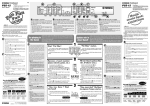
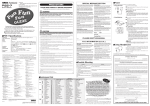
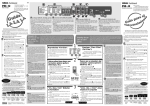
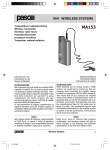
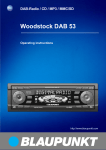
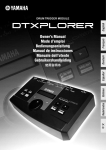

![6YX]Ybib[gUb`Y]hib[](http://vs1.manualzilla.com/store/data/006739463_1-1a3db6d52da2e3cdba32b34d7999ada3-150x150.png)

